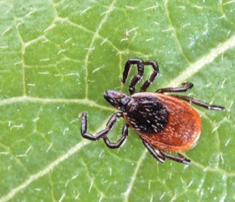Since 2020, we have been seeing an increase in Lyme disease cases, especially at the end of spring and during summer. For this reason, we would like to educate our clients who own dogs about ticks and how to prevent Lyme disease.
Ticks pose a challenge to both humans and animals alike. Their populations and activity are affected by the weather. When temperatures drop below 43 degrees, ticks fall into a deep sleep. When temperatures rise above 43 degrees, they come out in force, hungry for their next meal so they can complete their life cycle and reproduce.
While your dog probably won’t even feel the tick’s bite, it is packed with danger as it can cause Lyme disease in its host.
What is Lyme Disease?

Lyme disease is a bacterial illness transmitted to humans, dogs, and other animals by the deer tick.
It is caused by the spiral-shaped bacterium carried inside a tick and gets into a dog or person’s bloodstream through a tick bite. The most common symptoms of Lyme disease in dogs are:
- Lameness
- Swollen lymph nodes
- Joint swelling
- Fatigue
- Loss of appetite
The above symptoms typically occur at the chronic disease stage and as early as 2-5 months after infections, although signs can develop much later.
If Lyme disease is left untreated, symptoms can progress to kidney failure and even be fatal in severe cases. Serious neurological impacts and cardiac effects may also occur due to untreated Lyme disease.
Where Do Ticks Live?
You will most commonly find ticks outdoors in leaf litter, shrubs, or bushes. Ticks also exist in non-wooded areas. You can also find them in tall grasses. Ticks grab on to and cling onto passing animals. For this reason, it is essential to check your pet for ticks after you’ve spent any time outdoors. If you feel a small bump on your pet, be sure to part your pet’s fur and take a closer look.
How To Remove Ticks From Pets
There are old myths about how to remove ticks. Some people thought you could remove a tick by exposing it to heat. Another is dousing the tick with peppermint oil. Others believed that you had to twist the tick to get it out. These are neither safe nor effective methods.
For the safest method, watch the video from PetMD below.
How to Get Ticks Off Dogs: How to Kill a Tick and Remove the Head From Your Dog | PetMD
Lyme Disease Diagnosis and Treatment
Diagnosis is made by a combination of history, physical signs, and blood tests. From the blood test we can see if a dog has been exposed to the bacterium that causes Lyme disease.
Treatment includes antibiotics, usually for at least 30 days. However, it’s important to follow your veterinarian’s advice regarding follow-up care after your pet has been diagnosed with and treated for the disease.
Lyme Disease Prevention
The best treatment for Lyme disease is preventative treatment. Here are tips from the AVMA to help you prevent Lyme disease:
- There are several products that contain tick preventatives and, are very effective to help decrease tick exposure. The second method of prevention is vaccination. For the area we live in, we consider the Lyme disease vaccination one of the most important vaccinations for dogs. Please speak with us about which tick preventive product is right for your pet.
- When possible, avoid areas where you and your dog might come into contact ticks. These include tall grasses, marshes, and wooded areas.
- Check for ticks on both yourself and your animals once indoors.
- Clear shrubbery next to homes.
- Keep lawns well maintained.
Final Words
We know you want to be a great pet parent and keep your pets healthy to live happy lives. We are here to help you do just that and can answer any questions you may have about your pet. So, we hope you have found the above information helpful and follow it as best as possible. Please contact us if you have any questions or need to schedule your pet for an exam.
Sincerely,
Dr. Ashly Tuma
Pine Creek Animal Hospital







